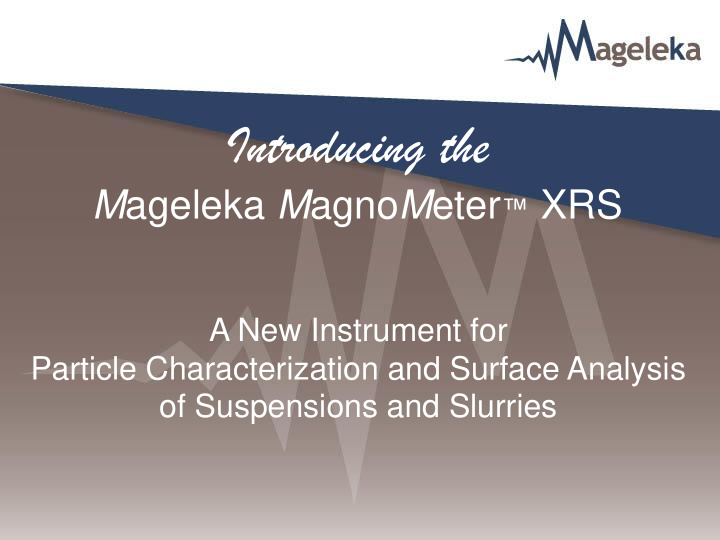



Introducing the M ageleka M agno M eter ™ XRS A New Instrument for Particle Characterization and Surface Analysis of Suspensions and Slurries
What is a M agno M eter? A device that uses NMR relaxation for non-invasive routine analysis of complex solid-liquid and liquid-liquid formulations Samples in water, solvents and melts No dilution required, minimal sample preparation Ideal for applications where speed of measurement and reliability are drivers of performance Research & development Quality control/quality assurance Process control labs
What is NMR relaxation? NMR relaxation time is a fundamental, intrinsic property of all solids and liquids Analogous to intensity of scattered light (particle sizing) and electrophoretic mobility (zeta potential) NMR relaxation measures how protons react, through their molecular motion, in a magnetic field Relaxation time of suspensions/slurries is intermediate between that for solid and liquid Value depends on specific particle-liquid combination Determined directly using an NMR spectrometer
Why use NMR relaxation? “ In every industrial application, a knowledge and understanding of the molecular structure and dynamics at the particle-liquid interface is critical to improving, or optimizing, suspension and ” emulsion product performance.
NMR Instruments High resolution NMR Low field NMR well-known technique for studying new technique for suspension and molecular structure and identification of emulsion analysis compounds high frequency needed low frequency optimal expensive, complex, inexpensive, simple sophisticated operation benchtop device intensive training easy operation university and analytical industrial R&D, QC/QA laboratories and process laboratories
What can you measure? Dispersed (wetted) Surface Relaxation Number Area of suspensions (liquids/suspensions/emulsions) Kinetic processes Adsorption/desorption Dispersed particle volume fraction Competitive adsorption Colloidal stability Molecular weight (polymers in Presence of para- and ferro- solution)* magnetic impurities Polymer and solvent viscosity Hydroxyl (OH) number of metal oxides Particle Size (<30nm) Oxygen and water content of solvents * By calibration
Applications “ The MagnoMeter can be used in an almost unlimited range of applications, and can measure samples at virtually any ” industrially relevant solids concentration. Graphene/Graphene Oxide Nanomedicine Cellulose nanocrystals Cosmetics Ceramics, refractories Food emulsions Minerals, metal oxides Agrochemicals Paints and inks Catalysts Dyes Paper pulp Pharmaceutics MOFs
Summary What does the M agno M eter provide? Direct information about the extent and nature of any particle- liquid interface → suspensions and emulsions any type of particle, and any liquid – including mixtures exceptionally wide concentration (0.01% to 90+%) no dilution required, minimal sample preparation small samples (typically 0.1mL; as little as 200 μ L) Complementary information to traditional particle characterization techniques Intelligence that is not possible with traditional techniques
Summary Advantages of the M agno M eter General Any colloidal-size suspension – virtually all liquids Measure locally with data manipulation at remote terminal Ideal for controlled or hazardous environments Multiple pod sensors facilitate sampling at different locations Frequency lock Measure mixture homogeneity Options and Extensions Large diameter NMR tube viscous liquids, concentrated slurries/emulsions MRI methods (imaging) in specific samples Can be adapted for use with an auto-sampler multiple sample analysis Can be adapted for flow-through operation
In Conclusion The M agno M eter finds use from Fundamentals to End-Use Performance Research & Development Basic formulation of products: reproducibility, stability (coagulation/flocculation), settling and sedimentation, shelf life Quality Control Release of raw materials, batch-to-batch reproducibility of final product Quality Assurance Enable release of complex systems which can currently only be characterized by the raw materials used rather than the manufactured product Process Management Follow and monitor milling and manufacture processes in almost real-time
Thank you! For more information, to send samples, to arrange a demonstration at your facility, or to speak to a technical applications specialist, please contact: info@mageleka.com +1 617 331 1130 www.mageleka.com
Recommend
More recommend